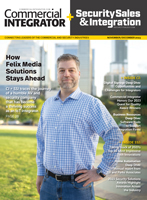How to Curb False Alarms
The city of Hastings, Minn., is on the warpath because home and business owners continue to have needless false alarms. What’s the big deal, you ask? After all, it’s their job to check them out anyway.
Hastings’ fathers are unhappy because last year police officers came running when more than 600 security systems falsely announced a break-in. For those who believe it’s no big deal, just think about the 600 passes they might have had time for in an attempt to identify illegal activities if they hadn’t been tied up on chasing their tails.
Alarm system owners should not be so quick to blame all their woes on the alarm companies that installed their system. In a 2007 false alarm survey taken by SSI, nationally improper disarming of alarm systems caused 63 percent of all false alarms; 62 percent were attributable to improper arming procedures. (Respondents were able to select more than one answer.)
Only 26 percent of respondents cited equipment issues as the cause of their false alarms, while 16 percent said it was installation problems. Forty-two percent, however, cited lack of proper training.
One way to curb false alarms is “alarm verification” which is where the central monitoring station (CMS) calls the premises first before dispatching the police. If there is no answer, the CMS operator will hang up and dial police dispatch to get some help out to the location in question. However, if the owner is there and provides a secret passcode, the CMS operator will not do anything.
According to SSI‘s research, “This single call resulted in reductions of 75 percent, leaving 25 percent as dispatched calls to unverified alarms.”
Another method, commonly referred to as “enhanced verification,” involves two or more phone calls before dispatching the authorities.
“By employing a second call, another 15 percent of the total calls received should result in no dispatch. If successful, this would represent an additional 60-percent reduction in dispatched requests to police” (False Alarm Statistics, published by SSI).
A third method, called “video verification,” provides a technologically advanced method whereby CMS operators can “look in” and view the premises during an alarm situation to verify whether anyone is there. In my next blog entry, we will look at the details behind this valuable false-alarm-reduction method. A list of manufacturers that make and provide this equipment will be provided.
If you enjoyed this article and want to receive more valuable industry content like this, click here to sign up for our FREE digital newsletters!

Security Is Our Business, Too
For professionals who recommend, buy and install all types of electronic security equipment, a free subscription to Commercial Integrator + Security Sales & Integration is like having a consultant on call. You’ll find an ideal balance of technology and business coverage, with installation tips and techniques for products and updates on how to add to your bottom line.
A FREE subscription to the top resource for security and integration industry will prove to be invaluable.








